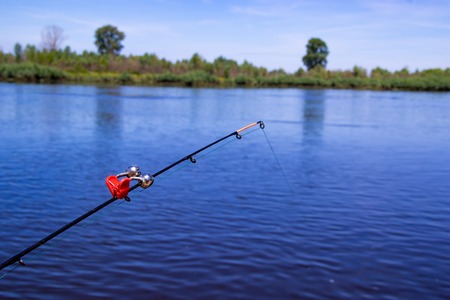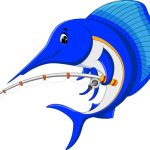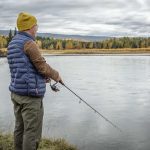Understanding Fall Fishing Patterns
As the leaves start to change and temperatures drop, fish behavior shifts dramatically. Understanding how fall conditions affect fish can help you choose the right gear and tactics to make the most of your time on the water. Cooler temperatures and shorter daylight hours trigger key changes in freshwater species across the U.S., including migration, feeding, and staging for winter.
How Cooler Temperatures Influence Fish
In autumn, water temperatures begin to decline, especially in northern states. This cooling trend causes fish like bass, crappie, and walleye to become more active during the day. They often move from deep summer spots into shallower waters where baitfish are more plentiful.
Common Temperature Ranges by Species (Fall)
| Species | Preferred Fall Temp (°F) | Typical Behavior |
|---|---|---|
| Largemouth Bass | 55–70 | Feeding aggressively in shallows |
| Smallmouth Bass | 50–65 | Schooling near rocky structures |
| Crappie | 50–65 | Moving toward brush piles and docks |
| Walleye | 45–60 | Migrating along river channels |
| Northern Pike | 45–60 | Cruising weed edges for prey |
The Role of Changing Daylight Hours
Shorter days signal to fish that winter is coming. This biological cue ramps up their feeding instincts as they prepare for colder months when food becomes scarce. Many game fish enter a “fall feeding frenzy,” making it one of the best times of year to target them with artificial lures or live bait.
Baitfish Movement Drives Predator Activity
Baitfish like shad and minnows also respond to dropping temps by moving into coves, creek arms, and warmer shallow areas. Predator species follow these schools closely, which means anglers should focus their efforts near these bait-rich zones.
Where to Find Fall Fish Based on Waterbody Type:
| Waterbody Type | Fish Location in Fall |
|---|---|
| Lakes & Reservoirs | Main lake points, flats near deep water, coves with baitfish activity |
| Rivers & Streams | Eddies, pools below riffles, slow-moving backwaters with structure |
| Ponds & Small Lakes | Docks, submerged brush piles, deeper holes close to shorelines |
By paying attention to temperature trends and daylight patterns, you can predict where fish will be staging and what kind of presentation will get them biting. In the next section, we’ll cover the essential gear you’ll need to match these fall fishing conditions.
2. Essential Tackle for the Autumn Season
As temperatures drop and fish activity changes, having the right gear is key to a successful fall fishing trip. Whether youre targeting bass, walleye, or trout, each species responds differently in autumn—and your tackle should match their behavior. Let’s break down the essential rods, reels, lines, and tackle setups that will help you make the most of the fall bite.
Rods & Reels
In fall, versatility is everything. Fish can be aggressive one day and finicky the next, so having a few rod-and-reel combos ready gives you flexibility on the water.
| Target Species | Rod Type | Reel Type | Recommended Action/Power |
|---|---|---|---|
| Bass | Medium-heavy casting rod (66″–7) | Baitcasting reel | Fast action / Medium-heavy power |
| Walleye | Medium spinning rod (6–7) | Spinning reel | Moderate-fast action / Medium power |
| Trout | Light spinning rod (56″–6) | Ultralight spinning reel | Fast action / Light power |
Fishing Line Choices
The right line can make a big difference when water clarity changes or fish get line-shy in cooler temps. Here are some go-to line setups for fall conditions:
- Braided Line: Great for heavy cover and deep jigging for bass. Use with a fluorocarbon leader for stealth.
- Fluorocarbon: Virtually invisible underwater—ideal for clear lakes and spooky trout or walleye.
- Monofilament: A solid all-around option with stretch and forgiveness, especially when using crankbaits.
Tackle Setups That Work in Fall
Your lure presentation should reflect what the fish are feeding on as they fatten up before winter. Match your tackle to seasonal baitfish patterns and water conditions.
| Lure Type | Best For | Why It Works in Fall |
|---|---|---|
| Lipless Crankbaits | Bass, Walleye | Covers water quickly; mimics fleeing baitfish in cooling lakes. |
| Jigs (with soft plastics or live bait) | Bass, Walleye, Trout | Slow presentations excel as fish become more lethargic in colder water. |
| Spoons & Inline Spinners | Trout, Walleye | The flash draws bites in low-light or stained water conditions common in fall. |
| Suspending Jerkbaits | Bass, Walleye | Mimics dying baitfish—a prime target during fall turnover. |
Tackle Tip:
If youre fishing during a cold front or post-front conditions, downsizing your lures and slowing down your retrieve can trigger bites from sluggish fish.
Quick Gear Checklist for Fall Fishing:
- A medium-heavy baitcasting combo for bass lures like jigs and crankbaits
- A medium spinning setup for live bait rigs or finesse soft plastics for walleye
- A light ultralight spinning outfit for casting small spoons or spinners at trout streams and lakes
- A selection of fluorocarbon leaders to reduce visibility in clear fall waters
This seasonal gear setup helps you stay prepared no matter where youre fishing or what species youre after this fall.
![]()
3. Top Lures and Baits That Trigger the Fall Bite
As water temperatures begin to cool in the fall, fish start feeding more aggressively to bulk up for winter. This makes it a prime time for anglers to take advantage of the seasonal feeding frenzy. Choosing the right lures and baits that mimic fall forage is key to success on the water. Below are some of the top-performing options that consistently produce bites during autumn fishing trips.
Crankbaits: Match the Hatch
Crankbaits are a fall favorite for targeting bass, walleye, and other predatory species. Their ability to imitate shad and baitfish — which become a primary food source in autumn — makes them incredibly effective. Use medium- to deep-diving crankbaits around points, drop-offs, and submerged structure where fish tend to congregate this time of year.
Recommended Crankbait Types:
| Type | Best Used For | Depth Range |
|---|---|---|
| Lipless Crankbaits | Covering open water & chasing bait balls | All depths (varies with retrieval speed) |
| Square-Bill Crankbaits | Bouncing off shallow cover like rocks or wood | 0–5 ft |
| Deep-Diving Crankbaits | Reaching suspended fish near ledges or humps | 10–20 ft+ |
Jigs: Versatile and Effective
Jigs are another go-to lure in fall because of their versatility and ability to mimic crawfish or baitfish depending on how theyre rigged. Football jigs work great along rocky bottoms, while flipping jigs shine around heavy cover like docks and brush piles. Pair them with trailers like soft plastic craws or swimbaits for added action.
Popular Jig Styles:
- Football Jigs: Great for dragging along gravel or rocky areas.
- Swim Jigs: Ideal for covering water quickly near grass edges.
- Flipping Jigs: Perfect for pitching into heavy cover or under docks.
Live Bait Options: Natural Presentation Wins
When fish get finicky, live bait can make all the difference. Shiners, minnows, and nightcrawlers all offer natural scent and movement that artificial lures can’t fully replicate. Live bait shines especially well for walleye, crappie, and catfish during fall months.
Top Live Bait Choices by Species:
| Fish Species | Best Live Bait | Presentation Tips |
|---|---|---|
| Bass | Shiners or large minnows | Hook through lips or dorsal fin; use slip bobber rigs |
| Walleye | Nighcrawlers or leeches | Crawler harnesses on bottom bouncers work well |
| Crappie | Minnows | Suspend below a float near brush piles or docks |
The right combination of lures and live bait can make all the difference during fall fishing season. Keep an eye on local forage activity and water conditions, and adjust your approach accordingly for the best results out on the water.
4. Cold-Weather Clothing and Gear for Comfort
As the crisp air of autumn settles in, staying warm and dry becomes just as important as choosing the right lure. Fall fishing can mean rapidly changing weather, chilly mornings, and damp conditions. Having the right cold-weather gear ensures you stay comfortable and focused on the bite.
Layering: The Key to Staying Warm
Dressing in layers lets you adjust your clothing based on the temperature throughout the day. Start with a moisture-wicking base layer to keep sweat off your skin, add an insulating mid-layer like fleece or down, and top it off with a waterproof outer layer to block wind and rain.
Recommended Layering System
| Layer | Purpose | Suggested Materials |
|---|---|---|
| Base Layer | Wicks moisture away from skin | Synthetic fabric, merino wool |
| Mid Layer | Provides insulation | Fleece, down, insulated vests |
| Outer Layer | Protects against wind and water | Waterproof/breathable jackets (e.g., Gore-Tex) |
Don’t Forget Your Extremities
Your hands, feet, and head lose heat quickly in cold weather. Investing in quality accessories can make a big difference during long hours by the water.
Cold-Weather Accessories Checklist
- Thermal Gloves: Look for water-resistant gloves that still allow dexterity for tying knots and handling gear.
- Thermal Socks: Wool or insulated synthetic socks help keep your feet warm even if your boots get wet.
- Insulated Hat: A beanie or hat that covers your ears helps retain body heat.
- Neck Gaiter or Buff: Protects your neck and face from wind chill.
Footwear for Wet Conditions
A good pair of waterproof boots is essential for fall fishing, especially if youre wading or standing on wet banks. Choose boots with good grip for slippery rocks and muddy trails, and consider adding removable insoles for extra warmth.
Pro Tip:
If youre going to be out all day, pack an extra pair of socks and gloves in a dry bag—just in case your first pair gets soaked.
Dressing smart for fall fishing not only keeps you safe but also makes your time on the water much more enjoyable. With the right layers and gear, you’ll be ready to tackle whatever autumn throws your way.
5. Tech Tools and Accessories for Autumn Angling
As the leaves start to change and the temperature drops, having the right tech tools and accessories can make all the difference in your fall fishing success. Whether youre chasing bass in a lake or trout in a river, these gear recommendations will help you stay organized, efficient, and on target.
Fish Finders & GPS Units
Cooler water temps mean fish are on the move, often schooling up or heading to deeper spots. A quality fish finder helps you locate them quickly, saving time and increasing your chances of a solid catch. Pair it with a GPS unit to mark productive spots and navigate safely through foggy mornings or unfamiliar waters.
Recommended Tech Tools
| Device | Features | Why Its Great for Fall |
|---|---|---|
| Garmin Striker Vivid 7cv | CHIRP sonar, GPS mapping | Pinpoints fish in deeper autumn waters with high clarity |
| Lowrance Hook Reveal 5 | FishReveal technology, SplitShot transducer | Makes it easy to see fish holding tight to structure during seasonal transitions |
| Humminbird Helix 5 G3 | DualBeam PLUS sonar, detailed mapping | Helps track fish as they follow bait schools during fall migrations |
Must-Have Fall Fishing Accessories
Headlamps & Lighting Gear
Shorter days mean more time fishing at dawn or dusk. A reliable headlamp keeps your hands free while tying knots, organizing tackle, or launching your boat in low light. Look for waterproof models with adjustable brightness settings.
Tackle Organizers
Fall fishing often means switching baits more frequently due to changing conditions. Keep your gear accessible with a well-organized tackle box or backpack system designed for quick access and weather resistance.
Boat Prep Tips for Cooler Weather
- Battery Check: Cold weather drains batteries faster—make sure yours is fully charged and carry a backup if possible.
- Dry Storage: Use waterproof bins or bags to keep electronics and spare clothes dry in case of sudden rain.
- Non-Slip Decking: Wet leaves and morning frost can create slippery surfaces. Add grip pads or clean regularly to stay safe.
The right tech tools and accessories don’t just make fall fishing easier—they help you adapt to the season’s unique challenges and take advantage of some of the year’s best bites. With a little preparation, you’ll be ready to hit the water confidently no matter how brisk the breeze gets.


